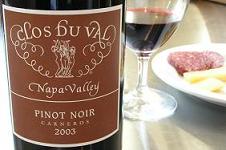Pinot noir enjoys a post-Oscar bounce...
March 15, 2005
 Just as I've always suspected, people are waiting for any excuse at all to drink good wine.
Just as I've always suspected, people are waiting for any excuse at all to drink good wine.When America embraced red wine as cardiac health food thanks to a "60 Minutes" report on the much-argued "French Paradox," the relationship seemed to move embarrassingly too fast. All of a sudden, people who drank no wine began drinking one or even two glasses of big red merlot every night, almost as if they'd wanted to do that all along anyway.
No one was fooled: in the moment, people drink delicious wine for hedonistic reasons, and we all know it. If somehow it also lowers my cholesterol level, that's perfectly all right too.
Marketing information giant ACNielson reports that pinot noir sales in the U.S. -- already rising and at record levels -- are up more than 15% since last October when the pinot-loving Oscar-winning wine buddy movie "Sideways" came out. I'm not giving anything away when I say this movie made no pretense of drinking for health reasons.
"Sideways" has created a frenzy for pinot noir as if the grape itself had won an award at Sundance. Even more compelling is the increase in repeat buyers of pinot by 40%, which is the sign of a new generation of pinot noir lovers being born right now. In comparison, repeat buyers of Miles' least-favorite wine merlot decreased 3% nationally, suggesting there just might be such a thing as bad publicity.
California wine giant Kendall-Jackson announced an astounding increase in pinot noir sales of 25%, and they're much more famous as a white wine producer, so go figure. Overall, this boost only pushes pinot noir from 1.1% of the market to 1.4% of the market. There's a long way for pinot to go, but it's a very big market.
Pinot noir has a long history in Europe where it's the principal red grape of the Burgundy wine region. The main white grape is another favorite, chardonnay.
Red and white Burgundy can be fantastic, but they have a tradition of being extremely expensive and of incomprehensible labeling. The wines are named after places -- Puilly-Fuisse and Chassagne-Montrachet are actual towns, for instance -- which makes them almost impossible to keep straight without a geographic memory.
Last week, just outside Boston, I stopped by a big wine retailer and found that things had really changed for pinot noir on the ground. This shop had just finished moving the California pinot noir section from wherever it had been to the very first row of the store. Next step is to add spotlights and a marquee.
2003 Clos Du Val "Carneros" Pinot Noir (about $24, widely distributed in North America)
Southern Napa and southern Sonoma meet at the north end of the San Pablo Bay, and the area where the two famous regions come together is called Carneros (car-NAIR-owss). It is both Napa and Sonoma and neither all at the same time.
Further inland, Napa and Sonoma are warmer, and their wines are ripe and flamboyant. Since it's so close to the water, Carneros is very cool and produces elegant and understated wines.
Clos Du Val has grown famous since 1972 for producing refined, focused wines that are true to the grape in quality and character. The new Carneros Pinot Noir is purple-red and radiant and full of forest aromas like leaves and green bark. The flavors are long lasting and persistent. It tastes like ripe bing cherry and black raspberry.
At barely $5 a glass, this Clos Du Val is a tremendous bargain that's flexible with food. You could serve this pinot with everything from pork or chicken to salmon and tuna and even lean beef.
© 1988-2025 by Jonathon Alsop
336 Washington St. Brookline MA 02445-6850 617-784-7150
jalsop@invinoveritas.com
Guarantee of Privacy Copyright Reminder